Do you long for beautiful, bright flowers that grow back each year and adorn your small home garden?
Choosing yellow perennials will be the best choice because they add a perfect balance of color and bloom every year.
Yellow perennial flowers will brighten any garden with their bright hue while attracting many pollinators.
You can decorate your garden with popular yellow perennial flowers like Heliopsis’ Tuscan Gold’, Tuscan Gold, American Gold Rush, Spurge, and Winter Aconite, which bloom at different times, heights, and zones.
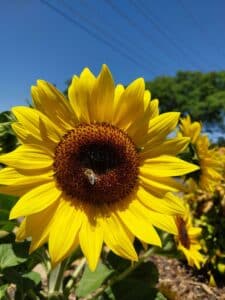
In fact, you can choose from many different perennials appropriate to your garden.
However, remember that each flower will have specific needs, hardiness zone, and care requirements.
Read more to find out the best selection of yellow perennial flowers.
Table of Contents Show
What Perennial Plant has Yellow Flowers?
Many perennials are gifted with yellow blossoms, which will bloom at different times of the year.
In fact, you should grow yellow perennials when planning your garden to balance color, especially those with more green or black and white plants.
The color yellow is associated with joy, fun, hope, and enthusiasm!

If you are wondering, many perennial plants boast yellow blossoms, some of which are native and bloom every spring to summer.
Choosing native yellow perennials may be a good idea because they help lay the foundation of a healthy ecosystem by boosting species.
Most flowering perennials will grow from USDA hardiness zone 3 to 9 or above in different temperatures and heights.
Some attain taller stature, such as Giant Sunflower and Yellow Coneflower, while others remain short, like Golden Yarrow and Tickseed.
However, these perennials boast yellow blooms every spring to summer when they get 6 hours or more sunlight.
On the other hand, Winter Aconite (Eranthis hyemalis) is a cold-hardy perennial that displays small yellow flowers every winter.
Overall, the warmth of these sunny yellow perennials will bring more light to your garden and invite many different pollinators, which is a win-win.
15 Yellow Perennial Flowers with Names and Pictures
Are you planning to grow yellow perennial flowers in your garden?
Consider choosing from these various native and non-native perennials that will display rich and bright yellow blossoms each year.
Remember, choosing native species will require less water and maintenance and serve as a host to many pollinators.
A. Tall Yellow Perennial Flowers
Here are a few tall growing yellow perennial flowers.
1. Maximillian Sunflower (Helianthus maximiliani)
As the name suggests, Maximillian Sunflower is a bloomer that grows to a height of 6 feet and thrives as a prairie perennial.
Some may even attain a height of 10 feet when provided with full sunlight and rich phosphorus food.
Maximillian Sunflower is a late summer bloomer that boasts rich yellow flowers with deep yellow or brown nectar and pollen that hosts many beneficial bugs and birds.
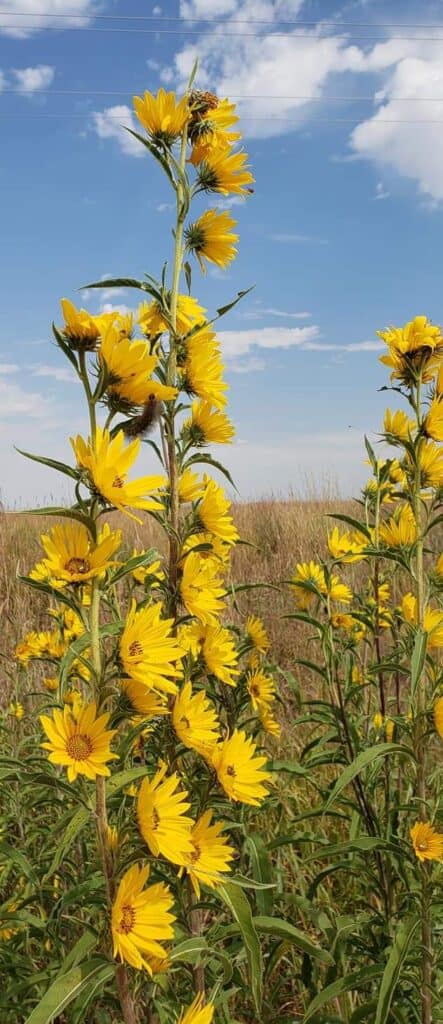
One tall Sunflower species is native to the lower 48 U.S. states and Canada. The flower can be five inches across with ray-shaped petals, and the center is one inch through.
When growing Maximillian Sunflower in your backyard, ensure weekly spring and summer water with over 6 hours of sunlight and slightly moist soil. It is one of the yellow perennials that bloom all summer.
Read on to learn about deadheading Sunflowers properly.
2. Yellow Coneflower (Ratibida pinnata)
Coneflowers are popular perennials that will come back yearly and display rich-looking flowers.
Yellow Coneflower is an herbaceous perennial that grows up to five feet and displays rich yellow flowers with drooping petals.
Native to eastern U.S. states, it will bloom throughout summer and fall but requires full sunlight to boast flowering.
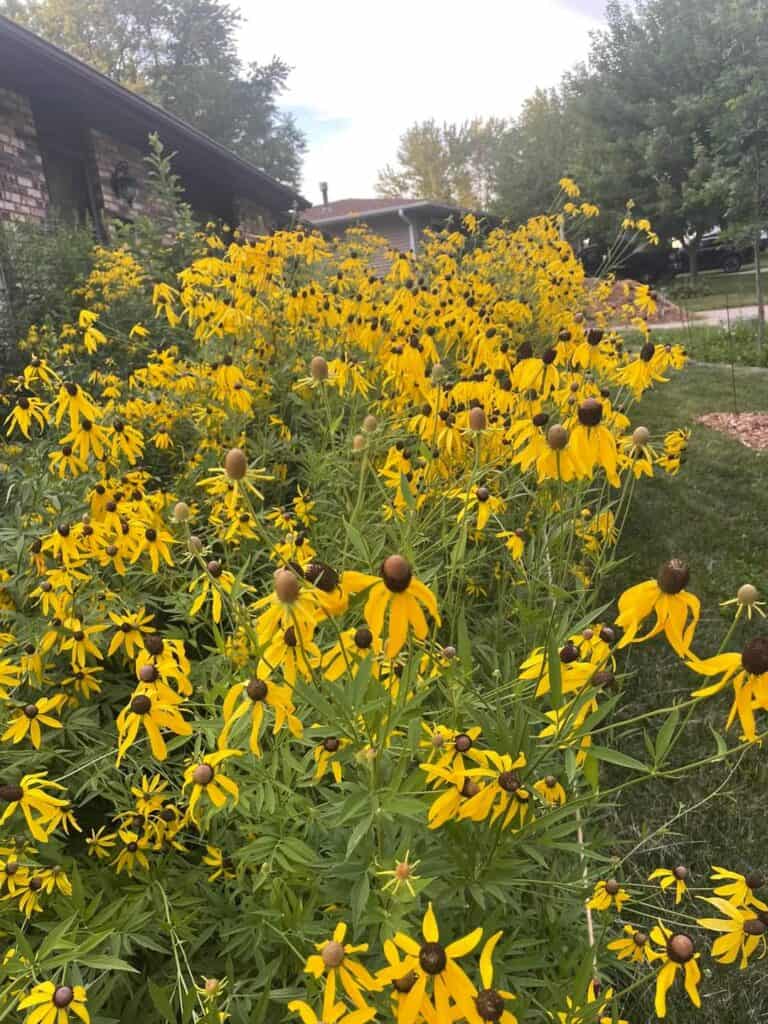
Most gardeners choose this plant for its cheerful, airy quality and unique cone shape. It can thrive in hardiness zones 3 to 9 and even survive heat, drought, and flooding.
Grow them along the garden borders, which helps attract birds, bees, and butterflies while repelling deer and provide full sun, sparse watering, and slightly moist soil.
3. Yellow Wild Indigo (Baptisia sphaerocarpa)
Yellow Wild Indigo, also known as “Bush Pea,” is a bushy or shrubby perennial that grows up to 3 feet in height and 60 to 90 cm wide.
It boasts bushier flowering covered with unique yellow blooms throughout spring and thrives in hardiness zones 3 to 8.

The name bush pea comes from its pea-like flowers that rise from stems and extend above a mound of clover-like foliage.
Provide partial or full sun with loamy, sandy soil that remains slightly dry for optimal growth.
Yellow Wild Indigo is a spring bloomer that will attract pollinators to the garden while repelling deer and other pests.
Remember, Yellow Wild Indigo is toxic when ingested; therefore, keep your children and pets away from the plant.
4. Giant Sunflower (Helianthus giganteus)
As the name suggests, Giant Sunflowers can grow up to 10 feet tall and boast bright yellow flowers spanning 3 inches in diameter.
These Giant Sunflowers grow mostly in wet meadows and swamps in Minnesota, Mississippi, South Carolina, and Alberta in Canada.
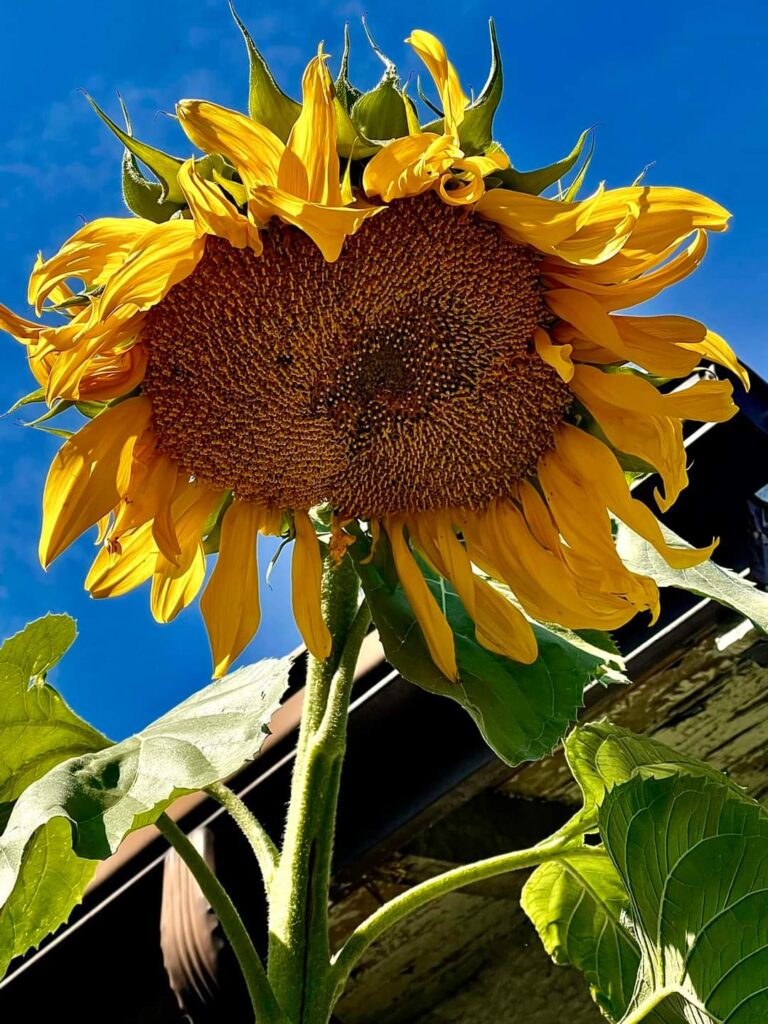
In the state of Illinois, the Gaint Sunflower is distinguished as a rare and endangered species.
The showy Sunflower grows one or more flower heads with 10 to 20 yellow ray florets on each flower head.
The flower bracts are medium green and covered with stiff minute hairs that serve as nectar for honeybees, bumblebees, butterflies, and beetles.
When growing in your backyard, provide well-drained, moist soil and full sun with moderate moisture to encourage larger plant size.
Note: Giant Sunflowers are late bloomers and may open blossoms in late summer or early fall.
B. Short Yellow Perennial Flowers
Here are a few short yellow perennial flowers for your garden.
1. Golden Yarrow (Eriophyllum confertiflorum)
Golden Yarrow, also known as Yellow Yarrow, displays rich yellow flowers in prominent clumps that give a bold impression to your garden.
However, this yellow perennial will hardly grow 1 to 2 feet; hence it attains a shrub’s height. Each flower ranges from 1/8 to 1/4 inch in diameter and often grows in a cluster.

Native to California, it is easily found in chaparral, coastal sage shrub, and southern oak woodland.
Yarrow plants are known for their flat-topped clusters of tiny flowers and feathery leaves. This one will specifically grow yellow blossoms.
Expect Golden Yarrow to bloom from late spring to early fall; some may even bloom until early winter.
However, provide full sun and well-drained dry soil with a pH between 5.0 to 8.0 for optimum growth.
2. Golden Columbine (Aquilegia chrysantha)
Golden Columbine is a bushy perennial that prefers shade to sun and blooms throughout spring with star-shaped yellow flowers.
However, it is considered a short perennial as it hardly grows over three feet.
Native to the lower 48 states of the U.S., it thrives in cool temperatures (Hardiness zone 3 to 8) and does well in the shady part of your garden.
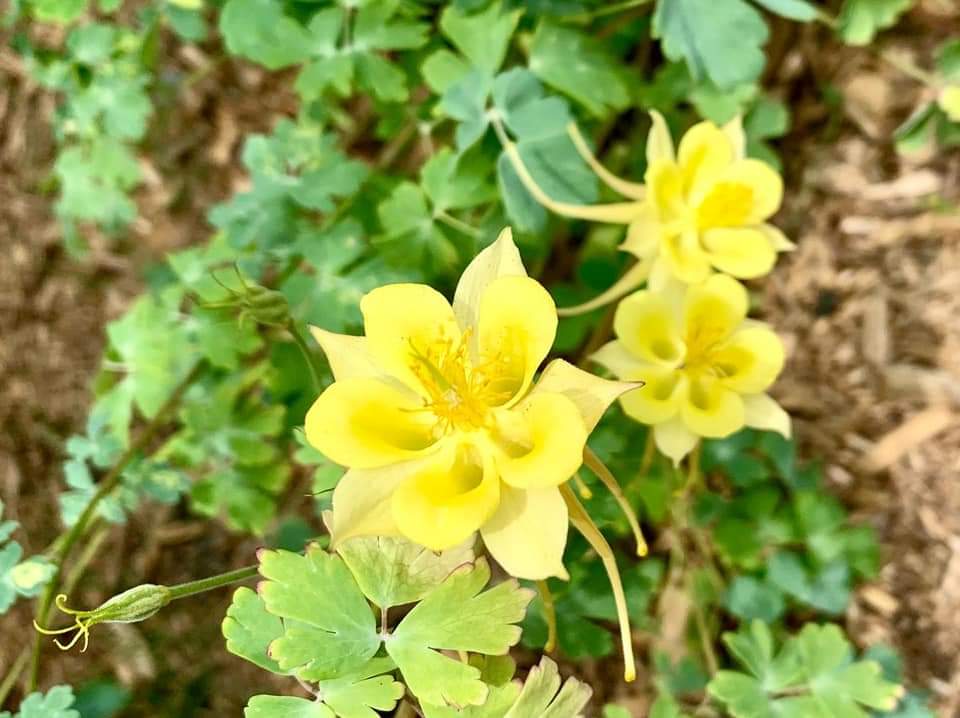
Golden Columbia perennial is a part of the Buttercup family that displays bright yellow to golden-yellow flowers up to 3 inches in diameter with sepals measuring 5 to 17 mm wide.
The flower stalks project outwards, giving it a shape of a star.
Provide these perennials with bright light to moderate shade to prevent wilted flowers, light watering each week, and well-drained soil with a slight acidity to promote healthy growth.
Remember to remove flowering stems once the blossoms fade in spring to promote additional blooms.
3. Tickseed (Coreopsis species)
Tickseed is a perennial shrub known for displaying brightly colored flowers that bloom every spring and summer.
Several Tickseed species are native to the United States, especially Tickseed Galaxy, which grows up to a foot in height.
Native to the Southern U.S., it does well in full and partial sun and thrives in hardiness zones 4 to 9.

Almost every Tickseed species grow daisy-like flowers 2 to 3 inches wide with multiple yellow rays surrounding a yellow center disk.
Many gardeners prefer growing it in meadows, walkways, and gardens as an accent or bordering plants.
It may be a good idea to grow Tickseed to repel deer and rabbits while inviting different pollinators.
Remember to provide 6 hours of full sunlight with loamy, well-drained soil to witness a healthy Tickseed plant.
4. Golden Aster (Chrysopsis mariana)
Golden Aster is another perennial shrub plant known for displaying showy yellow flowers.
Also known as Chrysopsis (krih-SOP-sis mar-ee-AY-nah), it is known to be native to the southern and eastern U.S. and mainly blooms around Florida.
The Chrysopsis boast daisy-like flower heads with yellow disc florets and yellow-ray florets measuring 1.5 inches across.

It is a late bloomer and mostly blossoms in late summer and fall once the temperature begins to cool.
They grow best in hardiness zones 4 to 9 in full sun paired with moist to wet soil, where they could attain a height of 1 to 3 feet.
Prove them with weekly watering in spring and summer to keep the soil moist for healthy root growth.
C. Seasonal Yellow Perennial Flowers
Here are a few yellow perennial flowers that blossom in different seasons.
1. Chocolate Daisies (Berlandiera lyrata)
Chocolate Daisies, also known as Lyreleaf green eyes or chocolate flower, is a yellow perennial flower native to Southern U.S.
A part of the Asteraceae family, it displays beautiful yellow flowers and green foliage in summer, which smell just like chocolate.
You would mostly find this yellow perennial growing as meadow and sidewalk flowers in West Texas.

A mature Chocolate Daisy plant would reach about 1 to 2 feet in height and display a small yellow flower with separated petals.
Care to grow them in a sunny garden location with well-drained yet disturbed soil usually found alongside the road.
Do not be shy when it comes to watering. Water every week when the first 2 to 3 inches of soil dry out.
The chocolate-scented Daisy blooms will attract different types of pollinators to your garden.
2. Sundrops (Calylophus berlandieri)
Sundrops, also known as Evening primrose, is a yellow perennial flower that grows best in full sun and warm weather typical to Southern U.S.
The shrub-like perennial prefers moist soil and full sun over 6 hours a day to display showy yellow flowers.
A mature Sundrop plant will grow 1 to 2 feet and display yellow flowers about 2 inches across with four broad, crinkled petals.

Sometimes, the flowers may appear in a pink, white or yellow shade.
Unlike other yellow perennial flowers, Sundrops will profusely bloom between March and November, with some even blooming in winter.
Keep the watering to a minimum and provide moist soil with a sandy or rocky texture throughout the year for optimum growth.
3. Yarrow Sub-Species
Did you know there are tends of Yarrow species grown throughout the U.S., but not all display yellow flowers?
Yarrow is a popular perennial plant that displays tightly-packed blooms in yellow, red, pink, or soft white.
However, most Yarrow will bloom from spring to early fall, making them sun-loving plants.
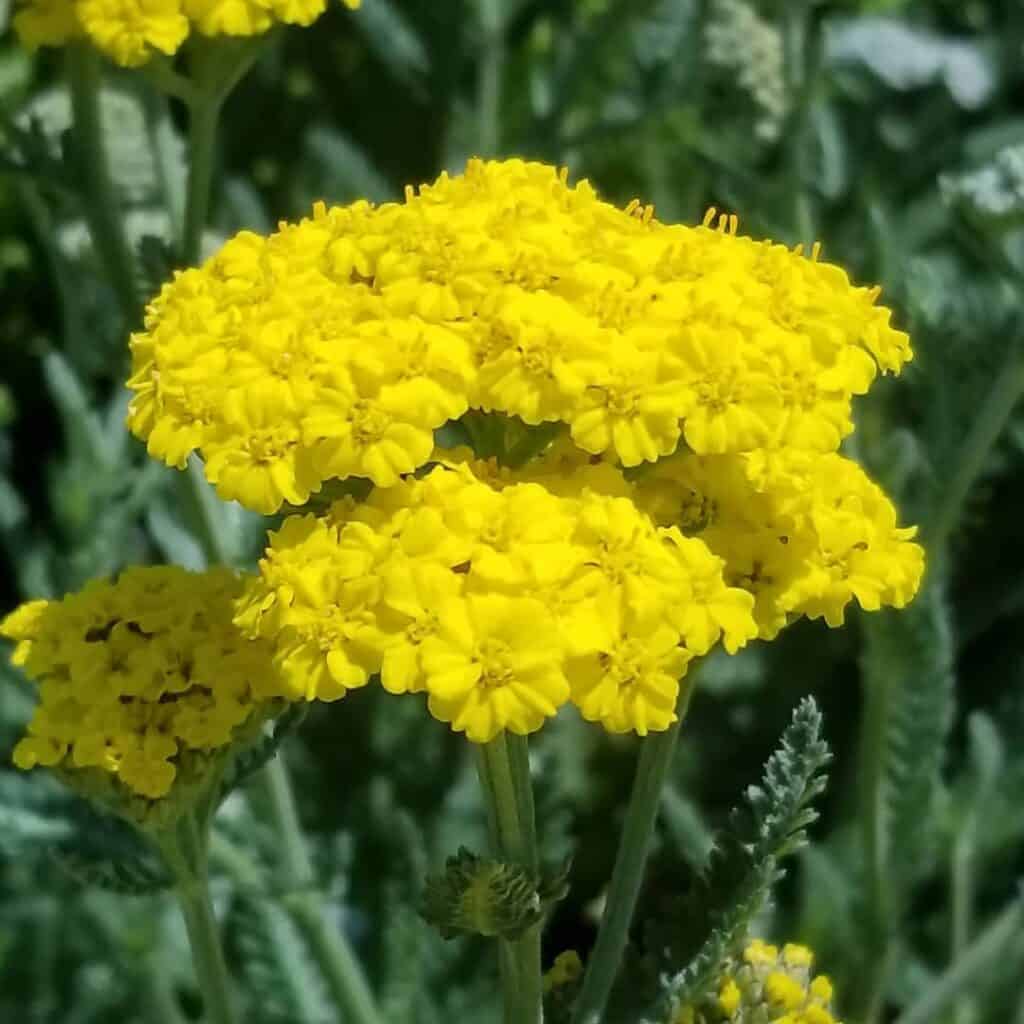
Most Yarrow will grow about 2 to 4 feet tall and display flowers in clusters.
Gold (Achillea filipendulina), Achillea tomentose, Moonshine, Paprika, and Summer Pastels are a few examples of perennial Yarrow with yellow flowers.
Most grow in hardiness zones 3 to 8 with well-drained soil and full sun but avoid the excessively wet ground.
The yellow Yarrow bloom will easily last up to 9 months with optimal care.
4. Winter Aconite (Eranthis hyemalis)
As the name suggests, Winter Aconite is a flowering species that fully blossoms in winter with beautiful, large-petal yellow flowers.
The perennial is found throughout southern Europe, America, and Asia, where it thrives in hardiness zones 4 to 9.
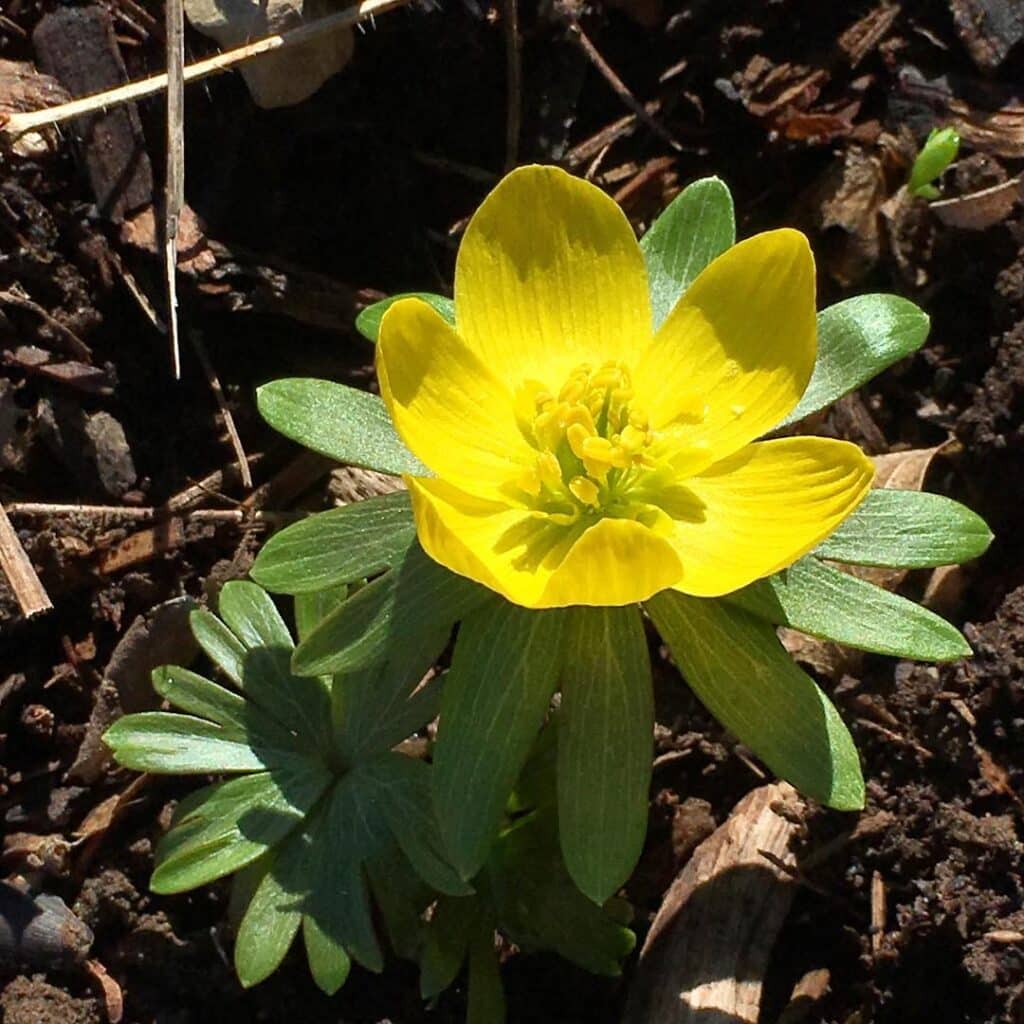
However, it is a short shrub that grows no more than 4 to 6 inches in height; therefore, you can consider growing them as blanket flowers.
Care to grow Winter Aconite in full or partial sun (with 6 hours of sunlight) with well-drained, alkaline soil and minimal watering.
When left unattended, the Winter Aconites may spread rampantly and take over the garden.
10 Yellow Perennial Flowers with Distinct Features
Are you not sufficed with the list of yellow perennial flowers listed above?
Here is a list of a few more yellow perennial flowers that will add to your garden’s décor and create a contrasting appeal.
| Yellow Perennials | Specification | Image |
|---|---|---|
| Damiantia (Chrysactinia mexicana) | 1. It is a drought tolerant evergreen shrub native to Texas. 2. It blooms throughout spring and sometimes in summer. 3. Provide well-drained soil with minimum watering and full sun. |  |
| Chrysanthemums | 1. They are flowering species native to East Asia and Europe. 2. They bloom profusely in late summer and autumn. 3. Provide at least 6 hour of sun and well-drained soil. |  |
| Tuscan Gold (Heliopsis helianthoides) | 1. The popular perennial plant boasts yellow flowers. 2. They are also known as the false sunflower. 3. They thrive in USDA zone 4 to 9 with full sun and shade and well-draining soil. |  |
| Echinacea X ‘Now Cheesier’ | 1. A Coneflower species displays deep, golden yellow blooms that lighten in summer. 2. They will bloom profusely from July to October. 3. Provide 6+ hours sunlight with moist to dry soil and USDA zones 4 to 9 |  |
| Lonicera Flava | 1. Also known as Yellow Honeysuckle, it displays yellow flowering vine. 2. It is native to central and southeastern US. 3. Grow them in USDA zones 5 to 8 with full to partial sun and moderate watering. |  |
| Black-eyed Susans | 1. It grows up to 2 feet in height and display showy yellow flowers. 2. Suits for landscape beds and garden borders. 3. Provide well-drained, moist soil in USDA zones 3 to 11. |  |
| Shasta Daisy (Leucanthemum x superbum) | 1. It displays daisy-like yellow flowers that may vary from banana cream to buttery yellow. 2. The plant grows up to 3 feet tall when provided with full sun and fertile soil with organic matter. |  |
| Azalea (Rhododendron sp.) | 1. These are spring blooming perennials known to display stunning yellow flowers. 2. The color may vary from bold yellow to creamy or mellow yellow. 3. They grow best in USDA hardiness zones 6 to 10. |  |
| Delosperma Congestum ‘Gold Nugget’ | 1. Also known as Gold Nugget or Ice Plant native to North America. 2. A true alpine succulent displays big and shiny yellow flowers. 3. The blossoms will appear from late spring to early fall. |  |
| Doronicum Orientale ‘Little Leo’ | 1. Also known as Leopard's bane requires moderate watering. 2. It grows up to a feet in full to partial sun. 3. It displays bright yellow and semi-double flowers. |  |
Learn more about 20+ Black and White Flowers
Conclusion
Choosing yellow flowers to adorn your garden may be the best decision, but ensure to grow perennial flowering plants that grow back each year.
Follow this guide to find the best yellow perennial flower for different hardiness zone, seasons, and weather.
Tell us in the comments if you have any favorite yellow perennial flowers missing from our list.
Related Article: 20+ Bell-Shaped Flowers


